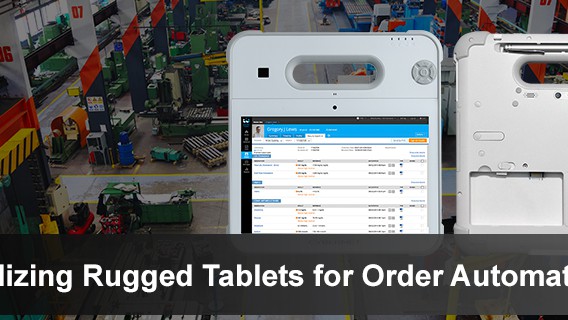With industrial computers and automation opening the floodgates for greater efficiency and optimization, warehouse managers have begun looking to integral parts of their operation to enhance for further productivity.
Order picking is one such essential part of the order fulfillment process. In fact, order picking is so integral to the overall process that it takes up as much as 55% of any given warehouse’s operation costs and 70% of the time spent within a distribution center.
So what is order picking? What is this gargantuan task that consumes so much of a warehouse’s resources? In short, it’s exactly what it sounds like- it’s the process of picking products from a warehouse in order to organize and fulfill customer orders.
That sounds simple enough, but hidden within that rather self-explanatory procedure is a world of depth. As with any process carried out in a warehouse, there are ways to automate, optimize, and streamline that open the door towards enhanced accuracy and productivity. Below are only a few best practices to consider if you plan on shifting your facility into next gear.
Run an ABC Item Analysis
Article Guide
According to the Pareto Principle, or the Law of the Vital Few, for most phenomena, about 80% of the effects that occur come from 20% of the causes. In a less roundabout explanation, it’s the idea that, in all things, performance and influence aren’t equally distributed. And the same can be said about goods. More often than not, top selling products are going to vastly outperform other products.
As a decision maker in your warehouse operation, it’s your responsibility to catch these well-performing products and optimize the picking process around them. Categorize your goods according to how well they sell. Items that are included in 50% or more of your orders are “A” items. Typically, these over-performers only make up 10% of your overall catalog. Slightly slower moving items will be ranked “B” and the slowest moving goods will be ranked “C.”
From there, rearrange your picking area in such a way that workers travel the least amount of time to grab “A” items. “B” items can be placed further back while “C” items can be placed the furthest away. The goal here is to cut time spent walking the floor by making the most popular items more immediately accessible.
Have the Right Replenishment System in Place
Now that item placement has been squared away, it’s time to move on to item replenishment. Nothing brings a warehouse to a screeching halt faster than an empty item slot. This holds especially true if we’re talking about an “A” item that has been depleted.
Of course, you’re probably more than familiar with replenishment systems and how essential they are to a warehouse operation. However, there’s more to restocking than just ordering more of an item that’s been run dry. There are actually a few different replenishment systems that stand to deliver better results depending on the specific type of warehouse they’re implemented in.
Day Replenishment
Like the name implies, a day replenishment system focuses on restocking only the items needed for that specific day. While not very effective for warehouses with many SKUs, smaller operations with less items can benefit from this lower cost system.
Top-off Replenishment
In contrast with day replenishment, top-off replenishment will restock the same item multiple times a day. During down time, each item is filled to capacity before more orders come in and picking/fulfilling processes commence. Naturally, this process is more geared towards warehouses with very short picking windows and much faster moving SKUs that require regular replenishment.
Opportunistic Replenishment
Opportunistic replenishment focuses on moving a very large amount of items to the picking location. Since often two to four weeks’ worth of items will be moved at a time with this method, it’s often recommended for warehouses with exceptional foresight and forecasting. The method could also be perfect for warehouses whose orders are often uniform and don’t fluctuate very much throughout the year.
Enhance Inventory Accuracy with Integrated RFID
Of course, perfecting your item replenishment game means keeping a close eye on your available inventory. Unfortunately, even in the highly automated world of order fulfillment, mistakes happen. Double checking every step of the order fulfillment process for inventory sounds like a natural practice, but it doesn’t necessarily scream “quick and streamlined.”
Giving your workers access to an RFID scanner built into an industrial grade tablet that’s carried with them around the floor can address both speed and accuracy concerns for a warehouse. Order accuracy is ensured since items can be quickly scanned by workers as they’re picked for shipping, and available inventory can be updated in real time as they’re taken off the picking floor. Inventory can even be scanned as it’s brought into the warehouse, ensuring you always the most up-to-date numbers when it comes to stock.
Using the insight provided by real time RFID scanning, you can go on to implement one of the replenishment methods we mentioned above that fits best within your specific operation.
Pick the Right Picking Method
Arguably most important in optimizing your order picking is choosing a picking method that best cooperates with how your warehouse is run. Like replenishment systems, warehouses have a few options when it comes to how they pick items for an order. How well your factory can optimize depends on how well you know your operation and can select a method that facilitates that operation.
Pick to Order
The original flavor of order picking, pick to order is exactly what is sounds like: an employee receives a list of placed orders and will walk the warehouse, picking the products in those orders before heading back, packing them, and shipping them out.
The pick to order method is perfect for smaller warehouses since it hardly requires extra automation and its startup costs are relatively low. Conversely, the process is manual, making it effective but not scalable. Many factories will start out with this process before moving on to bigger and better when their operation grows.
Batch Picking
With batch picking, multiple orders are put together into one pick instruction. If, for example, three orders are placed and all of them ordered a toothbrush with one other miscellaneous item, the pick order would have a worker walk the floor and grab all the toothbrushes first, bring them to the sorting area, and then pick out the other items. Essentially, “batches” of items are picked, then one-off items are picked, then the items are sorted into their respective orders and shipped.
Batch picking works best for warehouses with lots of SKUs and multi-product orders. Workers will make fewer trips since they’ll be grabbing several items across multiple orders at a time, and there’s less clutter on the picking floor, making for an easier time picking the items as well. If your orders are exceptionally complicated, however, you may notice that sorting and consolidating them after batch picking might actually add time to the overall process.
Zone Picking
Zone picking is like an enhanced version of batch picking. Workers are assigned to specific “zones” and will stay in those designated areas. Order cartons, each associated with a specific order, will move through these zones and all a worker will need to do is grab items from their zone and place it in the carton before it moves on to its next destination.
Zone picking’s main selling point is reduction of wasted movement by keeping workers in one spot and minimizing the possibility of human error. Larger orders can be fulfilled more quickly and factory managers may even notice a cut in training costs since workers only need to be trained for the responsibilities of one section.
Warehouses looking to implement zone picking should stay on top of their forecasting and demand. If certain products become incredibly popular, workers assigned to those stations could become much busier than others. Consider a rotating schedule if you notice this is the case with your operation.
Cluster Picking
Cluster picking involves using a multi-tote or bin that allows workers to pick up items for multiple orders at the same time. Naturally, this cuts down on time spent walking the floor and the more consolidated pick lists help workers pick items more accurately.
This method of picking is notably more complex than the others we’ve mentioned above and requires a pretty sophisticated warehouse management system to ensure clusters are assigned and delegated properly. Therefore, cluster picking might be better off not considered for factories without the startup capital or enthusiasm to experiment necessary to implement it.
Get in Tune with Your Specific Operation
A common thread for many of these tips is that there’s no clear right way to implement them. Warehouses are very volatile in the way they are run, especially when you consider how much a business’ scale contributes to how orders are taken and fulfilled.
Optimizing your order picking requires you to have an integral understanding of how your warehouse is run and the type of business it receives. The more data and insights you have regarding that, the better you can implement the right strategies that stand to enhance your business. For more information on how you can employ industrial computers and tablets towards drawing those important insights, contact a professional from Cybernet today.
Utilizing Rugged Tablets for Order Automation
June 21, 2016
Regardless of the products that a company produces and distributes, the process of completing orders is always very similar. Orders come in, often in a variety of formats, including email, fax, phone, and online forms.…
0 Comments6 Minutes
How Can the Order to Cash Process be Improved with Industrial Computers?
September 15, 2020
Regardless of whether we’re discussing a B2B-based manufacturer or one that sells directly to consumers, the order to cash process is an essential one and one whose optimization should be prioritized. Thankfully, as…
0 Comments9 Minutes
You Can't
Learn from a Pop-up
But we can deliver knowledge to your inbox!
We dive deep in the industry looking for new trends, technology, news, and updates. We're happy to share them with you.
Knowledge, News, and Industry Updates Right in Your Inbox




